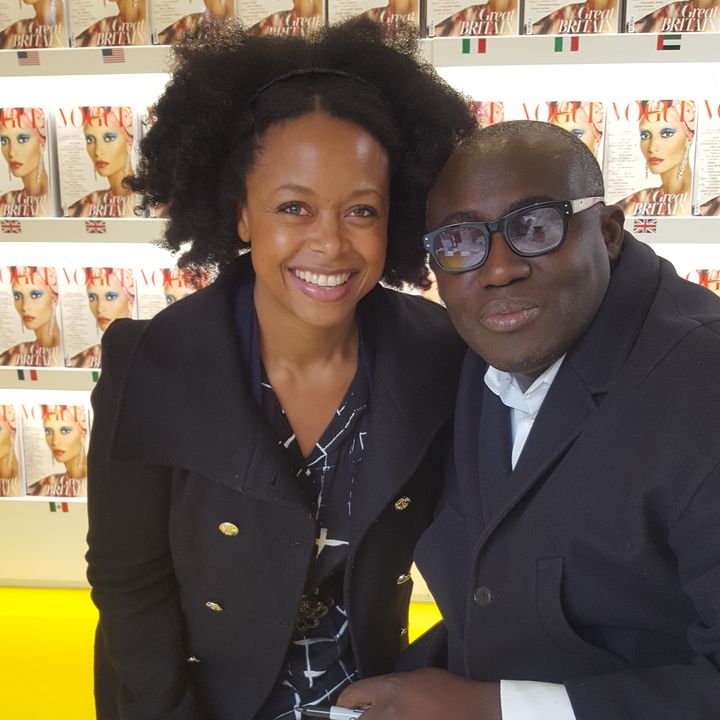The first time Vogue came on my radar was in 1999. I was 22, pretty much fresh out of university and I had landed a job at a small fashion PR consultancy, a stone’s throw from Vogue House.
I was so ill-equipped for the job, that in hindsight, I think I was like the Andy-experiment from The Devil Wears Prada film. I didn’t have the clothes, the connections, or the curve-less figure. But I did have a degree from a top university, drive and determination, and I LOVED magazines. I got the job by calling the consultancy directly and asking if they had any jobs – and my boss told me that it showed I could do PR. Fashion demanded perfection though. And I’ll never forget the time a colleague and I accidentally sent out an email with King Regards, instead of Kind Regards. We walked on eggshells for the entire day waiting to be given a dressing down. But, I digress.
For a girl like me, from an ordinary family of Caribbean immigrants, Vogue was not coffee table reading. I remember once we had a list of journalist names in the office, and I asked my colleague: “Who’s Alexandra Shulman?” Well, my boss heard that and exploded. How could I not know that was the editor of Vogue? She was completely stunned. That was one of the most important pieces of information I had to learn.
Note to self: learn the journalists’ names. So, I did. And when Vogue fashion director, Lucinda Chambers, came into the office to view the collections we represented, I was in awe. She arrived with a colleague, almost as if floating on the ether, dripping in fur and diamonds.
I remember feeling so inadequate the whole time I worked there, as I wore clothes that often cost £5 from the cheap shops in Harrow. My colleague had to show me how to hold a handbag, and I always looked a bit stiff and corporate. It took a couple of years before I learned how to dress like a media professional.
The gossip often turned back to the girl who had made it, someone called Marie Cre’ache. She was once just like us, I was told – a junior at the consultancy. Yet, she became a fashion features writer at Vogue. That was seen as mecca, and that was the jewel-encrusted carrot that was meant to get us through long days for little pay.
Yes, there is a reason why the fashion set are often whippet thin. The pay doesn’t leave much money for food, if you have to pay for rent and the latest labels.
I kept feeling that I didn’t fit in. Well, it wasn’t so much of a feeling, as a sledgehammer of unhappiness and displacement. I was relieved when I switched sides and went to work as a journalist for a less exclusive demographic.
Vogue was always something unattainable. Not something for me, despite my love of fashion, and style, and culture, and art. It was for girls who holidayed in Barbados, ate at The Ivy, and lived in Hampstead or Mayfair (at least that was what the fashion set, that I knew, were doing back in 1999).

But the #NewVogue under Edward Enninful’s watchful eye has changed all of that. There’s no longer a one-size-fits all ideal fashionista. Cover girl Adwoa Aboah may be from fashion royalty, but she’s mixed-race, outspoken and real, without the glossy veneer that the old Vogue was at pains to protect.
It feels that it’s no longer just about old money, or what labels you wear, but about your creativity, your resilience, and your ability to rise from the ashes. It’s about style that encompasses all colours, and all creeds. And not just one view of what it means to be black, or from an ethnic minority.
Last week, I stood in line at Conde Nast News International to meet the main man and pick up a signed, hardback copy of his first issue. The day was inclusive in every way. Edward Enninful greeted me warmly, and thanked me for coming. The only designer label on me was my Lulu Guinness rucksack gifted to me by my fashion-insider sister. I was, and am, resolutely high street with a bit of vintage, and I truly saw a democracy of fashion taking place. I felt included, and that there was a seat at the table for me.
#NewVogue is a place where an immigrant can rise through the ranks, and where public schooling is no longer the be-all and end-all. It’s come not a moment too soon. I’m proud to be a Vogue subscriber for the first time in more than 15 years. And proud that I’m seeing the changing face of magazine publishing with my own eyes.
